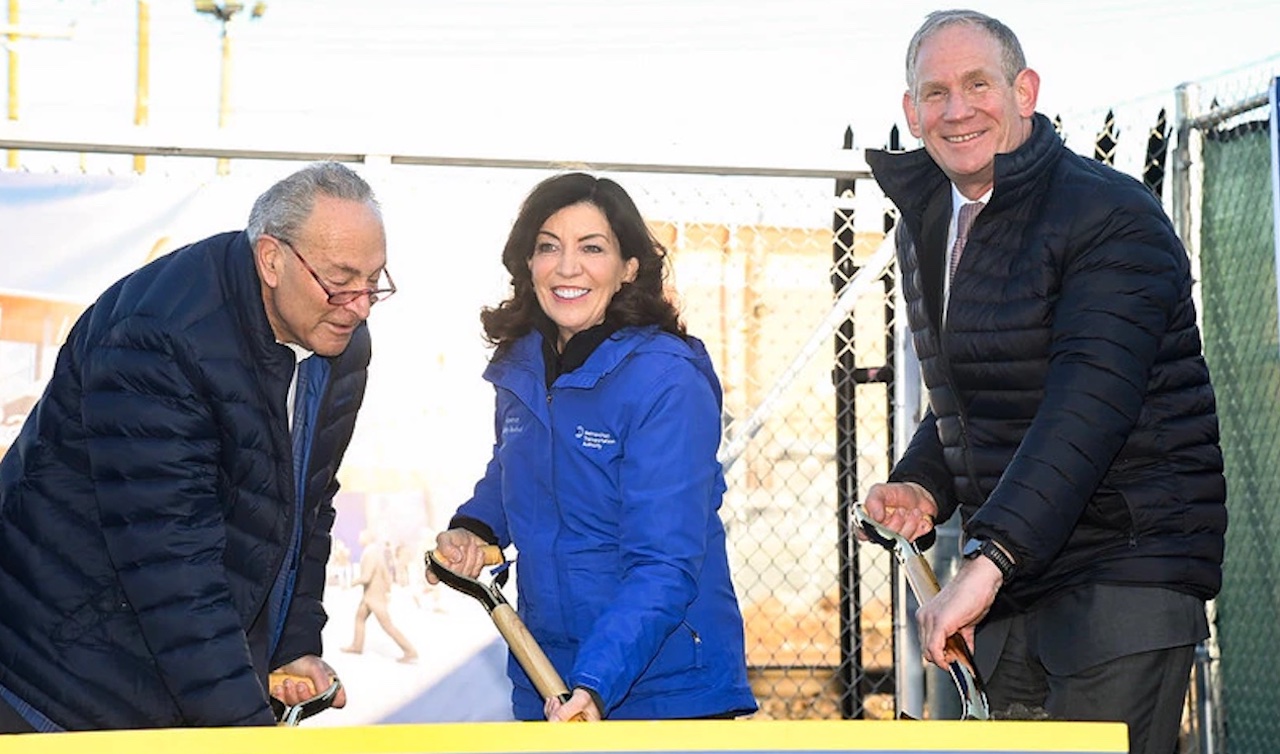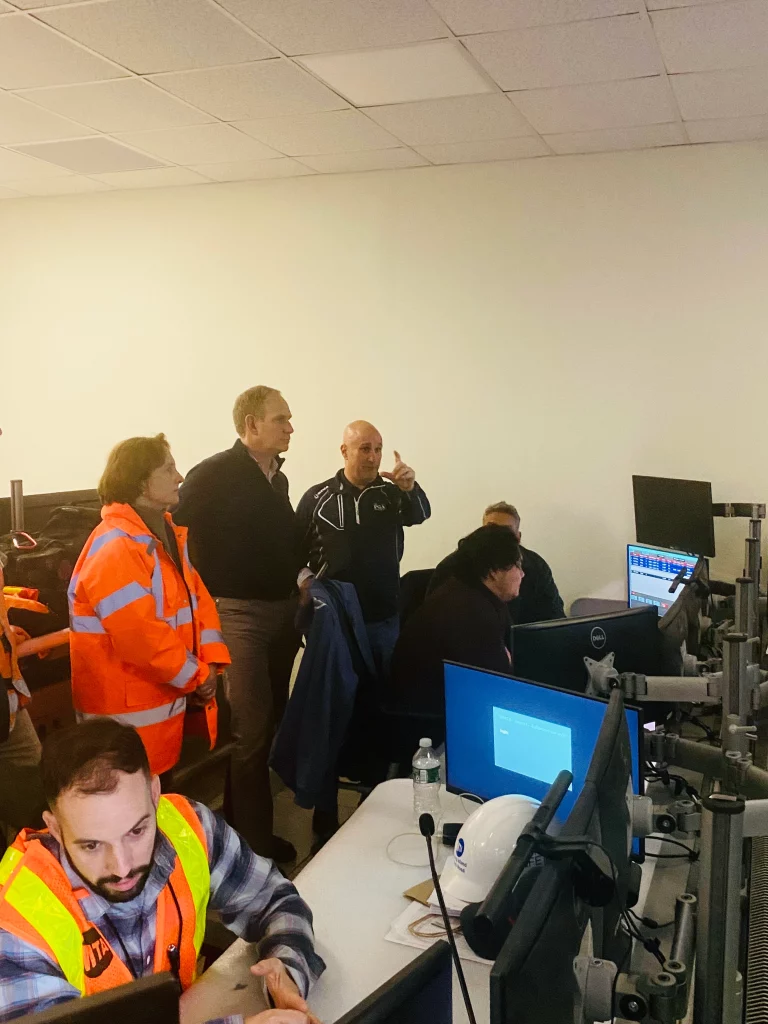
Transit Briefs: Metro-North, LIRR, SEPTA, TTC
Written by Carolina Worrell, Senior Editor
Metro-North's Penn Station Access project, which will add four new stations in the Bronx, broke ground on Dec. 9. Pictured (from left to right): Senate Majority Leader Chuck Schumer, New York Governor Kathy Hochul and MTA Chair and CEO Janno Lieber.
Metro-North’s Penn Station Access project breaks ground in the Bronx. Also, the Long Island Rail Road (LIRR) takes over operational control of Grand Central Madison; the Southeastern Pennsylvania Transportation Authority (SEPTA) receives award for “distinguished budget presentation”; and joint funding of up to C$1.5 billion will go to the expansion and rehabilitation of the Toronto Transit Commission’s (TTC) Bloor-Yonge Subway Station.
Metro-North
The Metropolitan Transportation Authority (MTA) on Dec. 9 broke ground on the Metro-North Penn Station Access project—the largest expansion of the Metro-North Railroad since its founding in 1983—which will add four new stations in the Bronx bringing rail service within one mile of 500,000 residents.
According to the MTA, by offering rail service to and from Manhattan, Westchester and Connecticut, this project will “expand access to jobs, education and entertainment for East Bronx communities and greatly reduce travel times, provide reverse commuting opportunities and offer a critical second route into Manhattan for the first ever through Metro-North.”
The four new stations will be in Hunts Point, Parkchester/Van Nest, Morris Park and Co-Op City and will be ADA accessible. According to the MTA, the expansion will use Amtrak’s Hell Gate Line to access Penn Station, “optimizing existing infrastructure and minimizing the construction impact on surrounding communities.” Metro-North trains stopping at the four new Bronx stations will serve as an extension of the New Haven Line from the New Rochelle Station, offering transit options in the East Bronx to Midtown Manhattan, as well as points in Westchester, Connecticut, and inversely.
In addition to the four new ADA stations, the project will turn the existing two-track railroad into a largely four-track railroad, with more than 19 miles of new and rehabilitated track work. This expansion to a four-track railroad, MTA says, “will provide service flexibility to support the increase in Metro-North and Amtrak trains expected to operate through the area and allow for workarounds in the event of a service disruption.”
The additional service, MTA says, “necessitates an expansion” of Metro-North’s New Rochelle Yard in Westchester, along with modernization of signal, power and communication infrastructure consisting of four new interlockings, five new substations, reconfiguration of the Pelham Bay interlocking and upgrade of two existing substations.
The project also includes rehabilitation work to repair and strengthen the Bronx River Bridge, Eastchester Road Bridge, Bronxdale Avenue Bridge and Pelham Lane Bridge to carry additional train traffic.
In September 2021, the Federal Transit Administration (FTA) issued a Finding of No Significant Impact (FONSI), allowing the project to proceed. On December 29, 2021, the MTA awarded the design-build contract to the joint venture of Halmar International, LLC and RailWorks.
According to the MTA, one of the first project elements to take place will be the construction of the Leggett interlocking, which will be located south of the proposed Hunts Point Station. Construction of actual passenger rail stations is expected to begin 2024 with anticipated completion for the Penn Station Access Project slated for 2027.
“Penn Station Access is a game changer for a huge and transit-deprived swath of the Bronx,” said MTA Chair and CEO Janno Lieber. “Five-hundred thousand residents live within just a mile of the four new Metro-North stations, and many more when you look at the entire service area. This project means dramatically shorter commutes and life-changing access to jobs, education, health care and everything else New York has to offer.”
“Grand Central Madison is bringing the LIRR, Metro-North and the subway under one roof for the first time,” said Metro-North President and LIRR Interim President Catherine Rinaldi. “Bringing Metro-North service to Penn Station will connect the subway, LIRR, NJ Transit, PATH and Amtrak, offering regional connections unlike anywhere else in the country. The completion of all transportation projects underway will redefine what transit looks like in the tri-state area and provide essential transportation to communities with limited options. Today, we celebrate a milestone that brings us closer to that reality.”
LIRR
The MTA on Dec. 11 announced that operational control of Grand Central Madison—the new 700,000-sq-ft LIRR terminal nearing completion underneath Grand Central Terminal—has been transferred to the LIRR from MTA Construction and Development, the MTA’s agency responsible for building the terminal.

According to the MTA, the transfer of control, which was overseen by the Federal Railroad Administration (FRA) and occurred at noon on Friday, Dec. 9, is a “significant step toward opening the new terminal” and “signifies that the rail operations at Grand Central Madison and the tunnels leading to it are now federally regulated railroad territory.”
“Today’s announcement means that Grand Central Madison is formally changing from a construction site to a railroad terminal,” said LIRR Interim President and Metro-North President Catherine Rinaldi. “This is a historic, major milestone for the project. The LIRR is delighted to have received this extraordinary nearly completed new train terminal and railroad staff are looking forward to safely beginning train service for customers.”
According to the MTA, the project is continuing the final stages of testing and MTA Construction and Development is remaining active on the site with contractors testing air flow and life safety systems, as well as the escalators and elevators.
The new terminal which will also enable the LIRR to accommodate anticipated customer demand to Manhattan when Amtrak begins a project in 2024 to rebuild its East River Tunnels to Penn Station, is expected to open before the end of the year. According to the MTA, Grand Central Madison is “the largest passenger rail terminal to be built in the country in 67 years and has been one of the largest transportation infrastructure projects in the U.S. in recent years.”
The two-level caverns support four platforms and eight tracks, and upon opening, “will provide Long Island’s commuters direct access to Manhattan’s east side, offer new commuting opportunities for reverse peak travelers, and enhance New York’s regional connectivity,” the agency said.
When the LIRR begins full service to Grand Central Madison, the MTA says it will “introduce the largest schedule increase in LIRR history,” adding 269 trains per weekday, a 41% systemwide service increase, to 936 trains per weekday from the current 667.
SEPTA
SEPTA announced on Dec. 8 that for the eighteenth consecutive year it has received the “Distinguished Budget Presentation Award” from the Government Finance Officers Association (GFOA) of the U.S. and Canada for the “detail, clarity and transparency” of its Fiscal Year 2023 Operating Budget presentation.
According to SEPTA, recipients of the award were required to “meet nationally recognized guidelines for effective budget presentation.” GFOA, a nonprofit professional association that serves nearly 18,000 government finance professionals throughout North America, “assesses the effectiveness of each agency’s budget as a policy document, financial plan, operations guide and communications device,” said the agency, adding that “budget documents must be rated ‘proficient’ in all four categories, and in the 14 mandatory criteria within those categories, to receive the award.”
“Our goal is to present this detailed information in ways that are accessible and understandable,” said SEPTA CFO Nikolaus H. Grieshaber. “This achievement is the highest form of recognition in governmental budgeting, and I want to acknowledge the incredible work of our entire team for creating this award-winning document.”
According to the agency, SEPTA has enhanced its budget document over the years, supplementing core data with charts and graphs to help explain details about funding, revenue, and expenses. The Fiscal Year 2023 Operating Budget included a new intro section emphasizing SEPTA’s value proposition to the region, key performance indicators on industry best practices, and streamlined sections for easier-to-understand descriptions of basis-for-budgeting practices. A one-page highlights sheet and a recording of the budget hearing were also shared online as additional resources for the public.
SEPTA’s Fiscal Year 2023 Operating Budget, as well as plans from other recent years, are available for viewing and downloading here.
TTC
Deputy Prime Minister of Canada and Minister of Finance Chrystia Freeland; Minister of Intergovernmental Affairs, Infrastructure and Communities Dominic LeBlanc; Ontario’s Minister of Transportation and Minister of Francophone Affairs Caroline Mulroney; and Mayor of the City of Toronto John Tory on Dec. 9 announced joint funding of up to C$1.5 billion for the expansion and rehabilitation of TTC’s Bloor-Yonge Subway Station to “improve efficiency and capacity and reduce overcrowding during rush hours.”
According to the Government of Canada, capacity improvement work at the station will include the construction of a second platform on Line 2 for eastbound service; an expansion of the Line 1 northbound and southbound platforms; new elevators, escalators and stairs; and construction of a new accessible entrance and exist on Bloor Street East.
These improvements will “enable more Greater Tornoto and Hamilton Area (GTHA) residents to use public transit and to get to and from their destination, reduce gridlock on roads, and help the TTC accommodate a projected growth ridership,” said the Government of Canada, which is investing up to C$500 million in the project through the Public Transit Infrastructure Stream of the Investing in Canada Infrastructure Program (ICIP).
“Bloor-Yonge station is home to one of the busiest lines in North America, and it is an important part of the routines of people from across the Greater Toronto and Hamilton Area—including my own family,” said Freeland. “Today’s announcement is great news for Toronto, and it is critical to ensuring we have reliable public transit for the riders who use it every day.”


